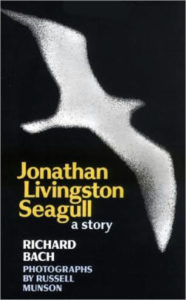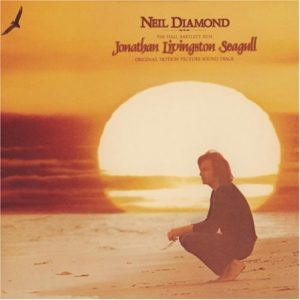
Nowadays, New Age is everywhere. Some are into nature sounds (I particularly enjoy writing while “rain” falls all around me), some into crystals, others dig reflexology.
But go back to 1970 and the concept of New Age was an obscure one. Some hippies were into Yoga, but by and large the New Age movement had yet to ignite.
The spark it needed was the 1970 publication of Jonathan Livingston Seagull. The tale of a seagull who wanted more out of life than fighting amongst other members of his species grabbed the nation’s attention that year, and became a runaway best seller.
And just like that, many decided the rat race was no longer for them. After all, what was the difference between clawing one’s way up the corporate ladder and fighting your fellow seagulls for a piece of rotted fish that had washed up on the shore?
Thus, Richard Bach’s tiny little novel (I read it in a single day when I was twelve) revealed the dissatisfaction that many Boomers and their younger parents had with their mundane lives.
Thinking like that was a million miles away from that of our grandparents, who were simply glad to have survived the Great Depression without starving to death.
But this was the Boomer generation. We questioned everything. Go to war? Not unless it’s for the right reason. Cut our hair? Why? Get a job? I’d rather join a commune.
While the WWII generation was mystified by the behavior of the rebellious offspring they had raised, Jonathan Livingston Seagull’s struggles with his desires to do his own thing perhaps cleared things up a bit for them.
Jonathan had a love for flying that his fellow seagulls just couldn’t understand. Eventually, he is banished from the colony. Undaunted, he does what he loves: flying. One day, he is met by a pair of gulls who take him to a heaven of sorts, a higher plain of existence. He is mentored by a mystical gull named Chiang who teaches him all sorts of cool stuff, including what we science fiction fans call teleportation. Jonathan then returns to earth to find and enlighten other dissatisfied seagulls.

Richard Bach (himself an Iowa Air Guard pilot) based the story on his friendship with a barnstormer of the twenties and thirties named Johnny Livingston. Livingston won many air races and also put on numerous exhibitions across the Great Plains with his biplane. The free-wheeling airman loved flying above all else.
The book proved to be such a hit that movie plans were put in place. Of course, the movie would have to be shots of real seagulls, given human voices. These voices would include those of Richard Crenna, James Franciscus, and Hal Holbrook, among others.
The movie was released in 1974 and in fact turned a profit, despite caustic reviews. Neil Diamond did the soundtrack, and managed to garner a hit single with Skybird. Lonely Looking Sky and Dear Father were also pretty good songs on an album designed to be listened to in a hot tub with the fondue pot heating up and margaritas in the blender.
Thus it was when we went in a big way for a tale of a seagull who wanted something more. Nowadays, many of us Boomers are casting uneasy eyes at our retirement funds with much the same feelings.